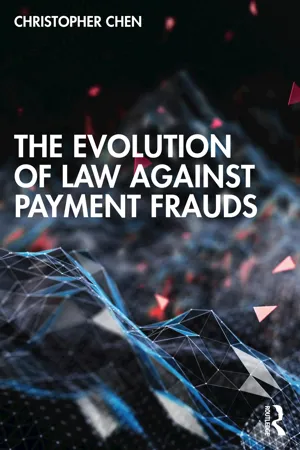
- 195 pages
- English
- ePUB (mobile friendly)
- Available on iOS & Android
The Evolution of Law against Payment Frauds
About This Book
This book examines the evolution of legal institutions in containing and tackling fraudulent activities plaguing payment systems ('payment fraud', e.g. forged cheques, wrongful payment instructions, etc.) in Asia, focusing on laws in Greater China and Singapore.
In the past century, the payment system has invited much innovation, changing the modes of payments from exchanging cash and coins to the use of cards, wire transfers and other new types of payment instruments or services (e.g. bitcoins or QR code payments). As the nature of payment services is to move money from one place to another, it naturally attracts fraudsters. Even with advanced computer technology, payment fraud is still rampant in the market, causing billions of dollars in losses globally per annum. Through an examination of payment instruments and associated frauds over time, the book illustrates a shifting trend of legal solutions from criminal sanctions and civil compensation to a gradual focus on regulations of payment intermediaries. This trend reflects the complexity of payment systems and the challenge of protecting them. The book also identifies the underlying actors and institutional characteristics driving the evolution of legal institutions to deal with payment fraud and illustrates how the arrival of new technology may affect the market and thus the evolution of legal institutions.
The book will help readers to better understand the interaction between technology, the market and law and help regulators, financial institutions, practitioners and end users, as well as about payment fraud and corresponding legal responses.
Frequently asked questions
Table of contents
- Cover
- Half Title
- Endorsements
- Title
- Copyright
- Dedication
- Table of Contents
- List of Abbreviations
- 1 Introduction: The Interaction of Law, Technology and the Payment Services Market
- 2 An Overview of the Evolution of Payment Services and Fraud
- 3 Front Metal to Paper: Fraud Related to Cash Notes and Coins
- 4 Fraud in Paper-Based Negotiable Instruments
- 5 The Evolution of Fraud Related to Card-Based Payment
- 6 From Physical to Digital: Fraud Related to Inter-Bank Transfer and Electronic Payment
- 7 The Future: Payment Fraud in Digital Payment Tokens
- 8 Reflection and Conclusion: A Shifting Trend of Anti-Fraud Legal Institutions
- Epilogue
- Index